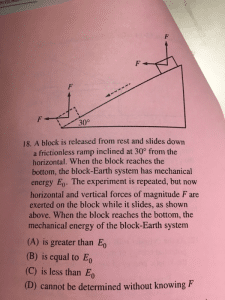a block is released from rest and slides down a frictionless ramp inclined at 30° from the horizontal. When the block reaches the bottom, the block-earth system has mechanical energy e0. The experiment is repeated, but now horizontal and vertical forces of magnitude f are exerted on the block while it slides, as shown above. When the block reaches the bottom, the mechanical energy of the block-earth system
A) is greater than Eo
B) is equal to Eo
C) is less than Eo
D)cannot be determined without knowing


To solve this problem, we need to understand the concept of mechanical energy and how external forces affect the mechanical energy of a system.
Mechanical energy is the sum of kinetic energy and potential energy. In the case of a block sliding down a frictionless ramp, the initial potential energy at the top of the ramp is converted into kinetic energy as the block slides down, and the total mechanical energy of the block-Earth system remains constant (ignoring any dissipative forces like air resistance).
When the block reaches the bottom of the ramp in the first scenario (without any external forces), the mechanical energy of the block-Earth system is Eo.
In the second scenario, where horizontal and vertical forces of magnitude F are exerted on the block while it slides, the external forces do work on the block, which affects the mechanical energy of the block-Earth system.
The work done by a force is given by the dot product of the force and the displacement vector. If the force and displacement are in the same direction, the work done is positive, and the mechanical energy of the system increases. If the force and displacement are in opposite directions, the work done is negative, and the mechanical energy of the system decreases.
In this case, the horizontal force does no work since it is perpendicular to the displacement of the block (assuming the block slides in a straight line along the ramp). However, the vertical force does work on the block as it moves along the ramp.
The vertical force can be resolved into components parallel and perpendicular to the ramp. The component parallel to the ramp opposes the motion of the block, so it does negative work, decreasing the mechanical energy of the system. The component perpendicular to the ramp does no work since it is perpendicular to the displacement.
Therefore, the mechanical energy of the block-Earth system when the block reaches the bottom with the external forces applied is less than Eo.
The correct answer is C) is less than Eo.